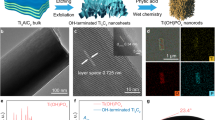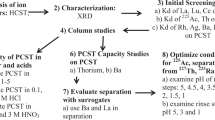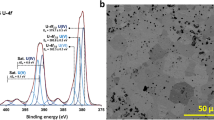Abstract
FUSED plutonium and uranium chlorides may be a good nuclear fuel for a fast breeder reactor1–4. The aim of the present work is to investigate some chemical properties of fused chloride components, in particular, the presence of dissociated or associated or non-ionic molecules, and the possibility of using the liquid salt–liquid organic extraction. Some recent results concerning the extraction processes with fused salts are presented in ref. 5. In the present investigation the salt phase contains: diluent (nuclear non-active): eutectic mixture of KCl–CuCl, 1 : 2 molar ratio, and fissionable material: uranium tetrachloride (prepared by the reaction, uranium dioxide + carbon tetrachloride at 450° C.) with a concentration of uranium tetrachloride of 1.5 per cent w/w. The salts were dried under vacuum by heating and fusing in the presence of dry hydrochloric acid and dry argon, at a temperature of 180° C. The organic phase contains: diphenyl as diluent and one of the following extractants: tri-n-octylamine (TOA), tri-n-butylphosphate (TBP), di-n-butylphosphoric acid (HDBP); dried in vacuum by heating. All components of fused salts were used as labelled atoms: copper-64, potassium-42, chlorine-36, uranium enriched, registered by suitable radiometry α, β, γ. The extraction process was carried out in a small volume, 1.6 ml., in 180° C, for 30 min. (15 min. with shaking): after separation of both phases (using different solidification temperature) they are dissolved: salt phase in nitric acid solution, organic phase in toluene or benzene. All operations were performed in glove boxes with dried atmosphere. The distribution ratio αextractantmetal for each metal is measured as ratio of total radioactivity of organic phase to salt phase (the volume ratio of the two phases is approximately 1). The results ere shown in Fig. 1.
This is a preview of subscription content, access via your institution
Access options
Subscribe to this journal
Receive 51 print issues and online access
$199.00 per year
only $3.90 per issue
Buy this article
- Purchase on Springer Link
- Instant access to full article PDF
Prices may be subject to local taxes which are calculated during checkout
Similar content being viewed by others
References
Goodman, C., Greenstat, I. L., et al., Massachusetts Institute of Technology, Report No. 5000 (1957).
Scatchard, G., et al., Massachusetts Institute of Technology, Report No. 5001 (1960).
Bulmer, I. I., et al., ORNL Report CF-56-8-204 (1956).
Taube, M., Nukleonika (in the press).
Gruen, D. M., et al., Second Intern. Conf. Atom. Energy, Geneva, 27, 112 (1958).
Author information
Authors and Affiliations
Rights and permissions
About this article
Cite this article
TAUBE, M., BORKOWSKA, Z. Organic Extraction from Fused Uranium Chlorides. Nature 192, 745–746 (1961). https://doi.org/10.1038/192745b0
Issue Date:
DOI: https://doi.org/10.1038/192745b0
This article is cited by
-
Investigations on the Physicochemical and Radiolytic Degradation Properties of Tri-n-butylphosphate–Ionic Liquid in the Presence of Nitric Acid
Journal of Solution Chemistry (2018)
Comments
By submitting a comment you agree to abide by our Terms and Community Guidelines. If you find something abusive or that does not comply with our terms or guidelines please flag it as inappropriate.



